Speech World Prices and the Australian Farm Sector

Philip Lowe
Assistant Governor (Economic)
Australian Farm Institute Agriculture Roundtable Conference 2011
Melbourne –
- Audio 15.01MB
Good morning.
Thank you for the opportunity to speak today about some of the challenges and opportunities facing the farming sector in Australia.
Perhaps more than any other parts of the Australian economy, farmers understand uncertainty. They live with uncertainty about rainfall and growing conditions. They live with uncertainty about the costs of their key inputs. And, of course, they live with uncertainty about the world prices for their outputs. It is this ability to deal with uncertainty that is one of the strong and enduring characteristics of the Australian farming sector.
This morning, I would like to begin by talking a little about some of the uncertainties facing the global economy. I would then like to discuss why it is that, despite these uncertainties, the medium-term global environment facing the Australian farming sector is quite favourable. And then finally, I would like to briefly touch on current conditions in the farming sector in Australia.
Global Uncertainties
It is clearly a difficult time for the world economy. Financial markets remain captivated by the unfolding events in Europe. The authorities there are dealing with a very difficult combination of excess government debt and weak banking systems. The problems are compounded by the weak growth prospects in the region and increasing fear of widespread contagion.
This situation is, in part, a legacy of many years in which a number of governments spent much more than they raised in taxes, with bondholders being more than willing to finance the difference at low interest rates. It is being compounded by the fact that the policy options facing the members of a currency union are more restricted than those that would face a country with its own currency.
In preparing the Reserve Bank's latest forecasts of the world economy, we have assumed that the European authorities do enough to avert a real disaster but are not able to avoid periodic bouts of considerable market volatility and uncertainty. There are, of course, a range of other scenarios, many of which, unfortunately, are on the downside. This inevitably means that there is likely to be considerable uncertainty about the global economy for some time.
But amongst the gloom emanating from Europe, it is important not to lose sight of what is going on elsewhere in the world. In the United States, recent economic data have generally been better than they were earlier in the year. It now seems clearer than it was a few months ago that temporary factors – including the rise in oil prices and the supply-chain disruptions from the Japanese earthquake – contributed to the weak US economic outcomes earlier in the year. As is normal though for a country having experienced a financial crisis, the recovery in economic activity has been slower than normal. Nonetheless, corporate balance sheets in the United States remain in good shape and a pick-up in business investment is under way. And importantly, there are few signs that the recent financial turbulence has led to the significant deferrals of spending on capital goods that caused so much damage in 2008 and 2009.
In Asia, growth remains firm, although below the pace in 2010. This moderation in growth partly reflects a general tightening of macroeconomic policy over the past year in response to a pick-up in inflation. Recently, there have also been some indications that the weakness in the North Atlantic economies is having an effect in the region, with growth in exports having slowed. But taking a slightly longer-term perspective, one encouraging development is that domestic demand in the region appears still to be growing reasonably strongly. This is important because over the years ahead, Asia will need to rely more on domestic consumption, rather than exports and investment, to drive its growth. To do this, further policy reforms in the region will be required, but progress on this front is being made.
So the global environment is a very complex one at the moment. Over the course of this year, forecasts for world growth in 2012 have been revised down from slightly above-trend growth to slightly below-trend growth. It is noteworthy that around three-quarters of the expected increase in global output is expected to come from the emerging and developing countries, a marked change from the past when the advanced economies accounted for the bulk of growth in global output. From Australia's perspective, global growth somewhere around average, or just a little below, would make for a relatively benign international backdrop. The difficulty for many other advanced economies is that average growth will not allow them to make inroads into their very high levels of unemployment and excess capacity, and this is likely to create both economic and social strains in these countries for some time.
The Global Environment Facing Farming
I would now like to look beyond these global macroeconomic risks to the medium-term global outlook facing the farming sector. And here the news is more positive.
In short, farming is benefiting from some of the same underlying forces that have led to an improvement in the outlook for the mining sector: namely, the development of Asia and the steady rise in incomes of the many hundreds of millions of people who live on the Asian continent. As incomes rise, especially from low levels, food consumption tends to increase, and the increase is concentrated in food with relatively high value added. There is also growing demand for agricultural products for energy production. And this increase in demand is occurring at a time when global growth in agricultural productivity has been slow by the standards of previous decades.
This changing balance in global demand and supply can be seen in the global prices for agricultural goods, which have increased significantly. As one example, the IMF's global food price index has almost doubled over the past decade, after trending lower in the 1980s and 1990s (Graph 1). While after adjusting for overall inflation, food prices are still just below their average over the twentieth century, the downward trend evident over most of the past 100 years appears to have stopped. And looking forward, there are reasonable prospects that higher prices are not just a temporary development. For example, in its latest review of world agriculture, the OECD is predicting that prices of a wide range of products over the next decade will be 20 to 30 per cent higher than their average over the past decade (after adjusting for inflation).[1]
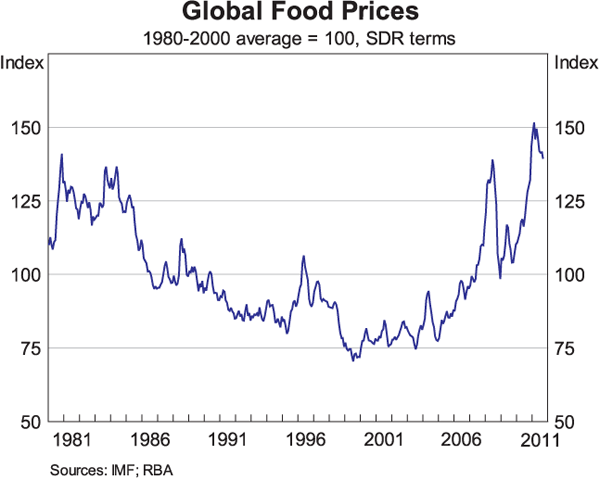
The higher prices of agricultural commodities – together with their greater volatility – have attracted the attention of policymakers around the world. Just last week, the G20 issued a comprehensive report looking at the reasons for these developments. Its central conclusion is that ‘marked shifts in the physical supply-demand balance … have been the main driver of the price fluctuations over the past ten years’ and that ‘for many commodities, the expansion of supply has fallen short of buoyant demand’.[2]
This buoyant demand for agricultural commodities is underpinned by rising food consumption per capita as incomes rise, particularly in Asia (Graph 2). Since the early 1960s, the number of kilojoules consumed on average per person across the planet has increased by almost 30 per cent. In China, the rise in average food consumption has been particularly pronounced, with food consumption per capita more than doubling over the past 50 years. And in recent times, there has also been a significant increase in average food consumption in the world's least developed economies, after there had been little growth for many years.
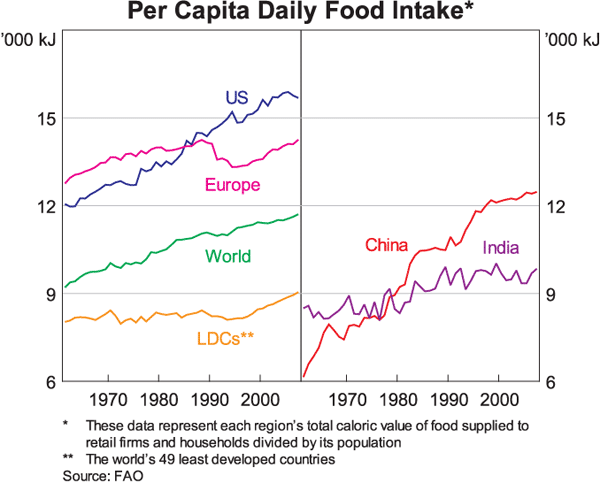
Looking at cross-country data, it is clear that higher-income countries consume much larger quantities of meat and sugar per person than do lower-income countries (Graph 3). In contrast, there appears to be little relationship between the average human consumption of grains and a country's per capita income. However, overall demand for grains does increase with income, given the use of grains as food for animals. One implication of these findings is that as average incomes increase over time, there is a tendency to consume more protein, especially meat. Over the years ahead, this switch in diets is likely to generate strong underlying growth in demand for a wide range of agricultural commodities.
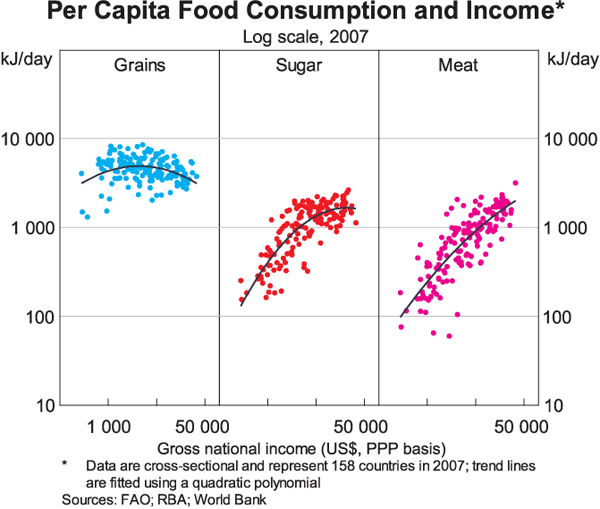
Another factor adding to global demand has been an increase in the use of agricultural commodities for non-food purposes, particularly for biofuels. In the United States, for example, bioethanol production now uses more than one-third of the total corn crop and, in Brazil, sugarcane is used extensively to produce ethanol. Globally, the OECD estimates that almost one-quarter of total sugar cane production is now used for non-food purposes, and this share is expected to increase significantly over the years ahead. Similarly, a substantial rise is expected in the use of vegetable oil for purposes other than food (Graph 4).
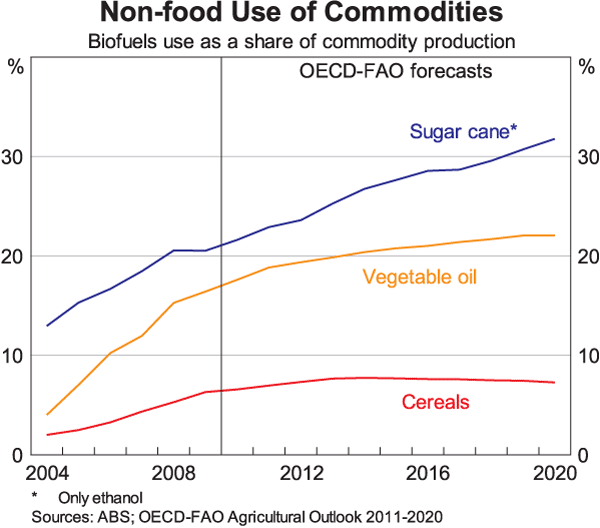
These developments on the global demand side have coincided with relatively modest expansion on the global supply side. In the years prior to the surge in demand, global research into improving yields was relatively low, as was investment in expanding the supply of arable land. This is one of the consequences of the low level of prices in the 1980s and 1990s. The result has been that the rate of growth in yields has slowed and there has been little growth in the area devoted to agricultural production over recent decades, partly due to the urbanisation process in Asia (Graph 5). Another factor affecting global supply has been an increase in the frequency of reported extreme weather events including droughts, floods and high temperatures.[3] Export bans imposed by some countries have also reduced the supply coming onto world markets.
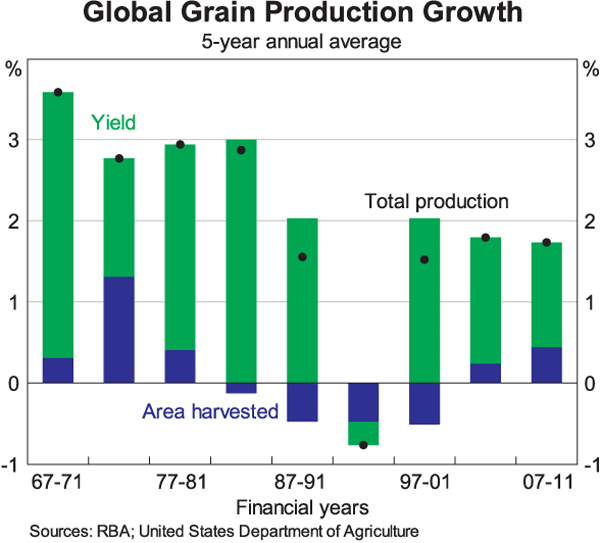
All up, these fundamental global drivers are reasonably favourable for the Australian farming sector. No doubt, global prices will continue to fluctuate in a wide range and there will be problems in individual markets. But the overall external environment is likely to be a relatively positive one over the medium term. And this external environment is being driven by some of the same underlying factors that have improved the outlook for the mining sector.
I would now like to turn more specifically to recent developments in Australia.
Developments in Australia
To begin with, it is worth noting that the high prices for agricultural commodities in global markets have flowed through to higher prices for many commodities in our domestic markets. However, the higher exchange rate has meant that the increase in Australian dollar prices has been less than the increase in foreign currency prices. In Australian dollar terms, the IMF's food price index that I showed earlier has increased by 40 per cent since 2004; this is substantially less than the increase in foreign currency terms, but significant nevertheless (Graph 6). The other notable feature of this graph is that the long-run swings in Australian dollar prices tend to be smaller than those in foreign currency prices. This is another illustration of the stabilising effects of our floating exchange rate; when commodity prices are high, the exchange rate tends to be high, and when commodity prices are low the exchange rate tends to be low, smoothing out the fluctuations in domestic prices. This provides an important source of stability for the economy as a whole.
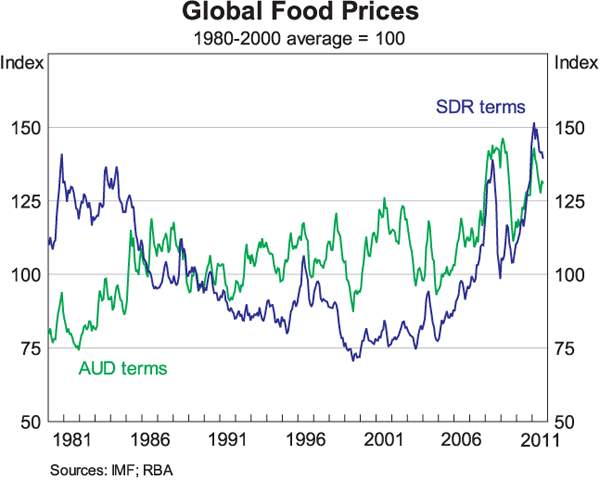
At the individual commodity level, there have been substantial increases in the prices of a number of commodities over recent years (Graph 7). While prices are generally lower than earlier in the year, partly due to problems in the global economy, most are substantially higher than they were a decade ago. This is true for the commodities in this graph as it is for lamb prices and the prices of many dairy products.
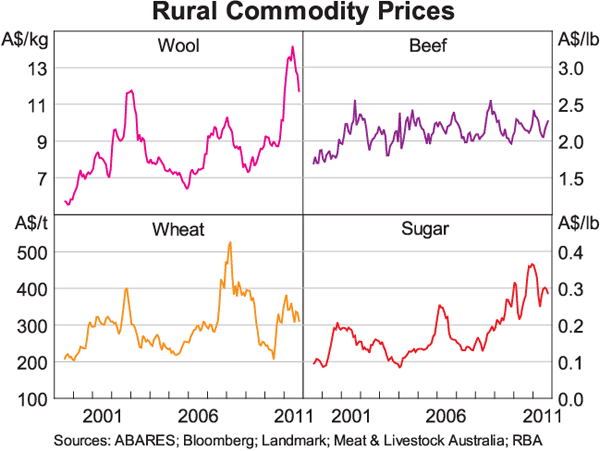
This rise in prices is the good news for domestic producers. The bad news is that the same forces that have driven up global prices have also put upward pressure on the prices of many inputs used by the farming sector. Obvious examples here are the higher prices of fuel, fertiliser and seed. For some parts of the industry, these increases in costs have been a significant constraint on profitability.
It is also important to recognise that there are substantial differences in the current situation across commodities. In particular, the producers of commodities whose global prices have not risen have found that the exchange rate appreciation and higher input costs have had a significant effect on their competitive position in global markets. One clear example is the wine industry, where the price of grapes internationally has not shown the same pattern as that for many other commodities, with the Australian dollar price of grapes falling significantly. As a result, the average Australian dollar export price for wine has declined by around 40 per cent over the past decade, and production has fallen over recent years. And according to its latest assessment, ABARES does not expect a reversal of this trend in prices any time soon (Graph 8).[4] A similar, although less dramatic picture, is evident for some horticultural products.
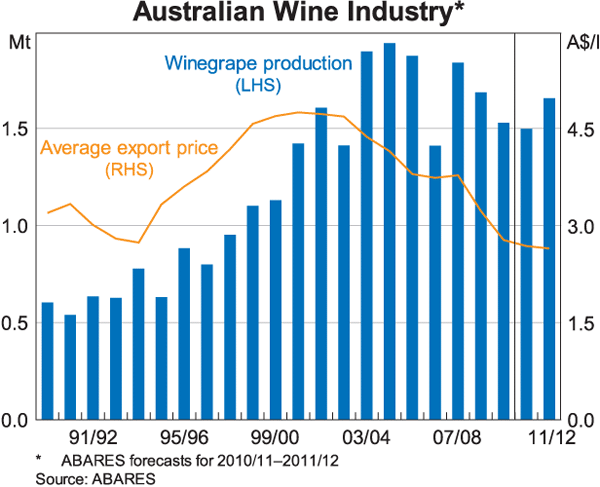
Turning now to the volume of output, as opposed to the price of output, the recent aggregate outcomes for the farm sector have also been generally favourable. According to the Australian Bureau of Statistics (ABS), farm GDP increased by almost 10 per cent in the past financial year, boosted by higher levels of rainfall. As one example, the winter wheat crop is expected to be a near-record high of around 40 million tonnes this year and this follows a good harvest last year. Taking a somewhat longer perspective, farm output has increased by around 70 per cent since the mid 1990s, although there have been a number of bad years over this period, particularly due to severe drought.
This combination of generally high prices and high output has provided a substantial boost to aggregate income of the farming sector over the past financial year, and another favourable outcome is expected this year (Graph 9). After adjusting for inflation, farm incomes over these two years are expected to be almost double the average of the previous two decades. As I mentioned earlier though, the picture is not uniform across the industry and some parts of the farming sector have experienced very difficult conditions over the past year. But overall, the current picture is better than it has been for some years.
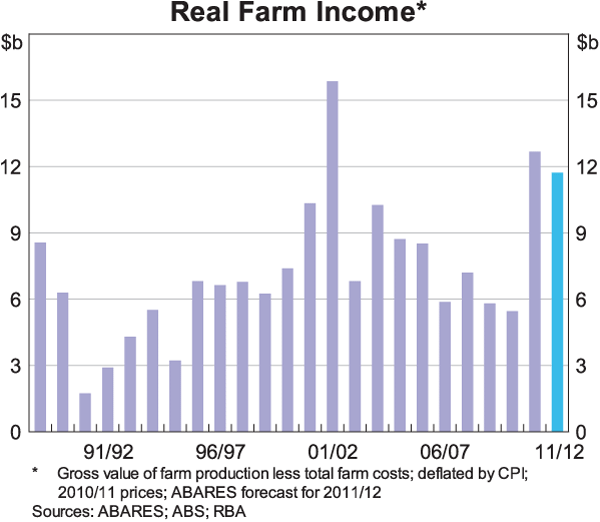
Of course, agriculture remains an industry whose fortunes can change quickly from year to year. And it is one in which very significant structural change has occurred over many decades. Given its importance to the overall Australian economy, it is also an industry that the Reserve Bank has paid close attention to over the years, and it continues to do so.
Looking forward, no doubt the fortunes of the industry will continue to wax and wane. And like many other parts of the Australian economy, the farming sector will need to continue the process of structural change. As I have talked about, this process is being driven, in part, by a fundamental realignment of global relative prices due to the re-emergence onto the global stage of the populous countries of Asia. This realignment of relative prices is creating new opportunities for Australian agriculture. I wish you success in finding those opportunities and in taking advantage of them over the years ahead.
Thank you.
Endnotes
I would like to thank Troy Gill, Ewan Rankin and Trent Wiltshire for assistance in the preparation of this talk. [*]
See OECD-FAO (Organisation for Economic Co-operation and Development and the Food and Agriculture Organization of the United Nations) (2011), OECD-FAO Agricultural Outlook 2011–2020, OECD Publishing, Paris. [1]
See G20 (2011), ‘Report of the G20 Study Group on Commodities under the Chairmanship of Mr Hiroshi Nakaso’, November, p 5. See also FAO, IFAD, IMF, OECD, UNCTAD, WFP, the World Bank, the WTO, IFPRI and the UN HLTF (2011), Price Volatility in Food and Agricultural Markets: Policy Responses, OECD Publishing, Paris. [2]
See, for example, G20 (2011), p 17. [3]
ABARES (Australian Bureau of Agricultural and Resource Economics and Sciences) (2011), Agricultural Commodities: September quarter 2011. [4]